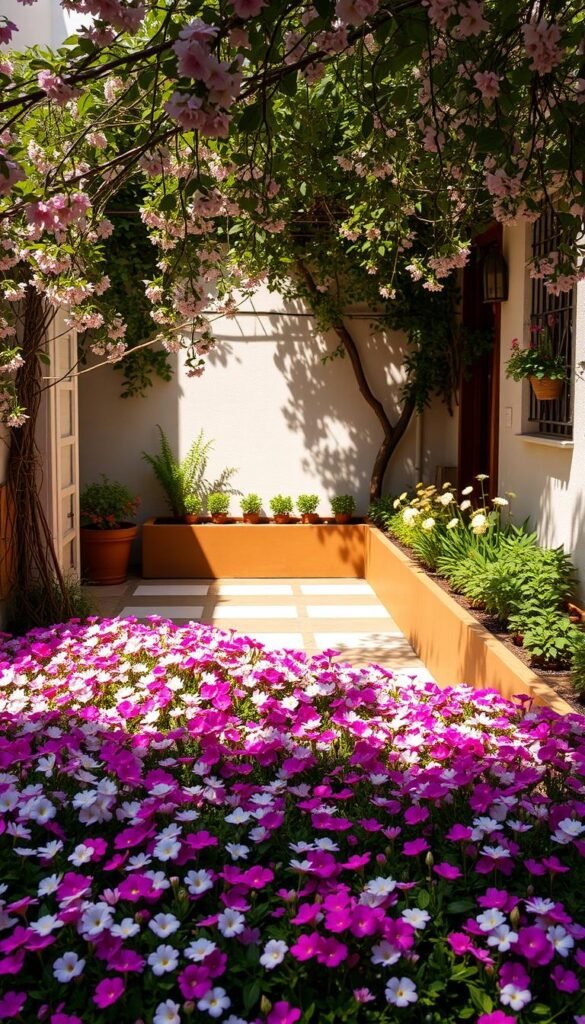Living in apartments or rentals doesn’t mean you have to give up growing plants. Container gardening lets you nurture greenery anywhere—balconies, windowsills, or even narrow stairways become opportunities for nature. These portable setups adapt to your lifestyle while keeping your connection to the earth alive.
You’ll find that even tiny areas can burst with color and texture. Mixing trailing vines with upright blooms adds depth, while combining foliage varieties creates visual interest. The best part? You don’t need a big budget—thrifted pots or repurposed items work perfectly.
Urban dwellers often use these arrangements as personal retreats. Tending to plants offers stress relief, turning care routines into mindful moments. Seasonal swaps keep displays fresh year-round—think cheerful pansies in spring or rich kale in winter.
Whether you’re new to gardening or refining your skills, this guide covers everything. Discover design tips, low-cost solutions, and plant pairings that thrive together. Let’s transform your compact corners into lively, uplifting escapes.
Embracing Container Gardening for Small Spaces
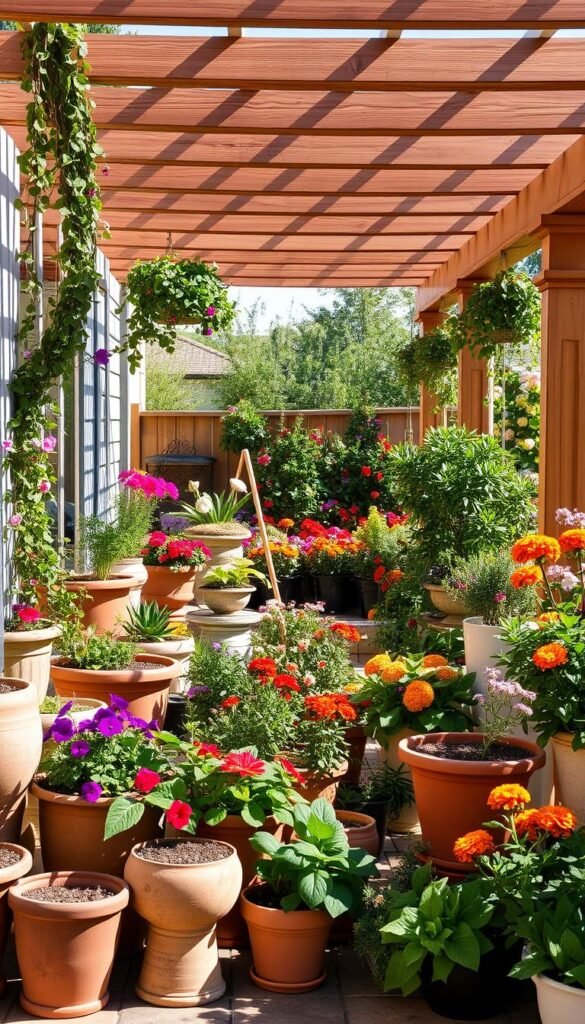
Your balcony or patio can thrive with smart container solutions. These versatile plant homes adapt to any area—whether you’re working with a shaded corner or a narrow ledge. The key lies in selecting pieces that balance function with personal style.
Choosing the Perfect Container for Your Mini Garden
Drainage matters most—look for pots with holes or add your own. Shallow-rooted herbs thrive in slim planters, while deep tomatoes need roomy homes. Lightweight resin works well for elevated areas, while terra cotta adds rustic charm to ground-level displays.
Mobility lets you chase sunlight as seasons shift. Consider wheeled stands or lightweight options for rearranging effortlessly. For cohesive looks, stick to 2-3 materials. Thrifted tins or colorful container gardening setups prove budget-friendly choices.
Balcony and Patio Inspiration
Maximize vertical real estate with railing planters or hanging baskets. Cluster varying heights near seating areas—tall grasses behind mounded petunias create depth. Always check weight limits before lining entire railings.
Dark corners? Try shade-loving coleus or ferns in glossy white pots to brighten the area. For sunny patios, drought-tolerant succulents in grouped containers make low-maintenance statements. Remember: odd numbers (3-5 pots) create visually pleasing arrangements.
Inspiring Mini Flower Garden Ideas: Compact Blooms and Creative Plant Combinations
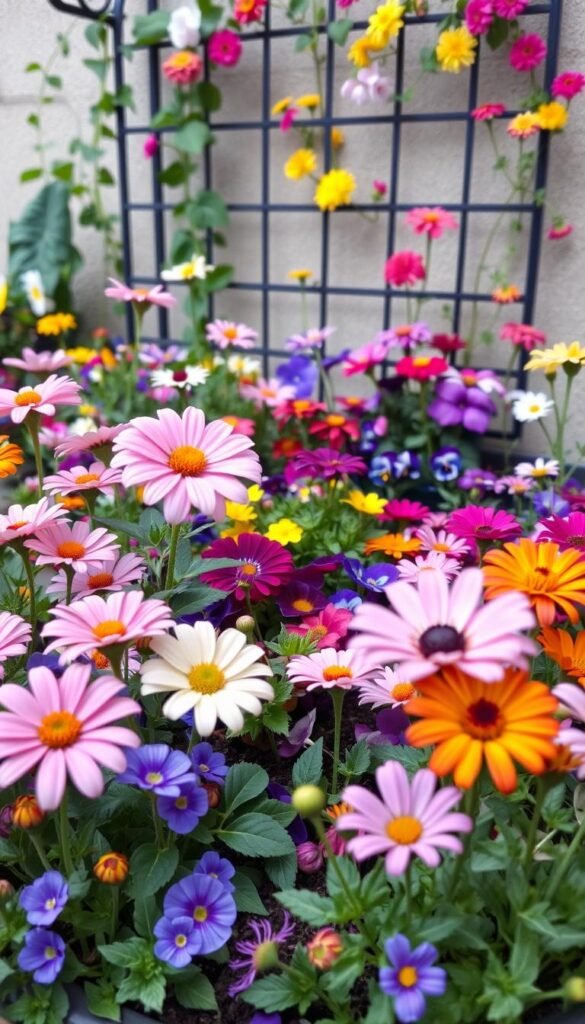
Small spaces burst with life when you master the art of strategic pairing. Density through repetition works wonders—try common daisies (Bellis) in fuchsia, pink, and white, interplanted with baby-blue forget-me-nots. Their velvety textures merge seamlessly, creating lush visuals despite limited roots.
For tabletop drama, blend miniature snapdragons in sunset hues with pansies. This combo delivers rainbow effects without crowding containers. “Bright shades sing when balanced by soft blues,” notes urban gardener Lila Torres. “Wispy forget-me-nots act like natural peacemakers between bold colors.”
Already own established greenery? Transplant sections into fresh arrangements instead of buying new. A cluster of daisies moved from a backyard bed can anchor a vibrant patio planter overnight.
Pro tip: Use odd-numbered groupings for centerpieces. Three pots with staggered heights leave space for dining essentials while showcasing your living artwork. Want more ways to elevate your space? Focus on mindful pairings that evolve with the seasons.
Compact Blooms: Maximizing Color and Texture
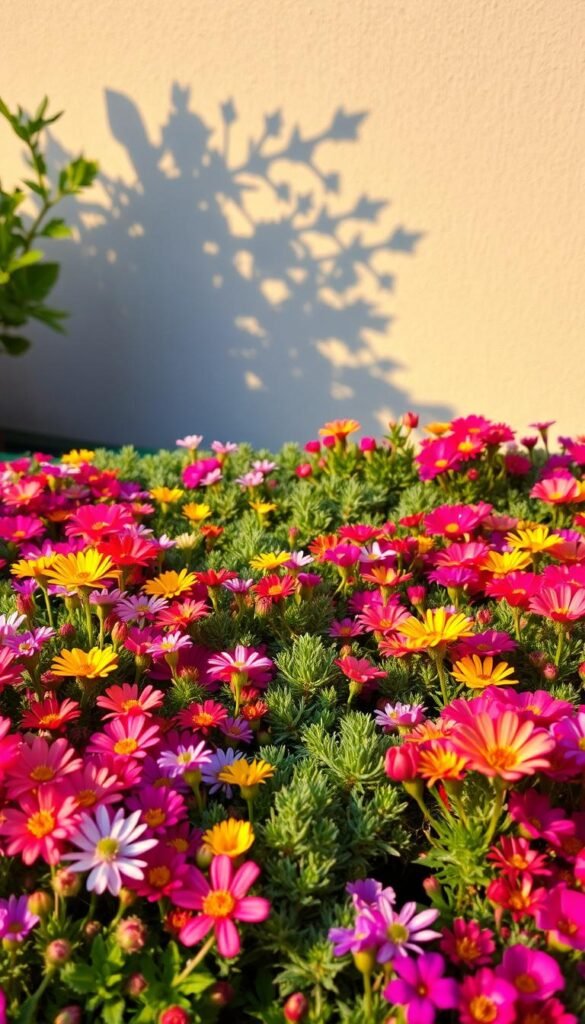
Transform limited spaces into vibrant showcases by mastering layered combinations. Strategic pairings of foliage and blossoms create depth that tricks the eye, making petite arrangements feel lush. Color contrast becomes your secret weapon—silver lavender leaves pop against burgundy violas, while bright orange petals add sparks of energy.
Mixing Varied Flower Types
Combine spiky salvias with mounding lobelias for dynamic texture. “The magic happens when you pair opposites,” says Denver gardener Marco Silva. “Delicate snowberries soften geraniums’ bold clusters beautifully.” Aim for three-season interest—summer-blooming lavender, spring violas, and winter berries thrive together in one planter.
Seasonal Blooms and Their Impact
Geraniums shine through heat waves when deadheaded weekly, offering months of ruby-red color. Time plantings to overlap bloom periods—tuck pansy seedlings between established fall mums for seamless transitions. Rotate 1-2 showstoppers each season while keeping structural plants like ornamental grasses year-round.
Pro tip: Use warm hues like orange near seating areas to energize, while cool purples create calm corners. This approach lets you curate moods through smart flower choices without redesigning entire spaces.
Designing Versatile Flower Beds for Mini Gardens
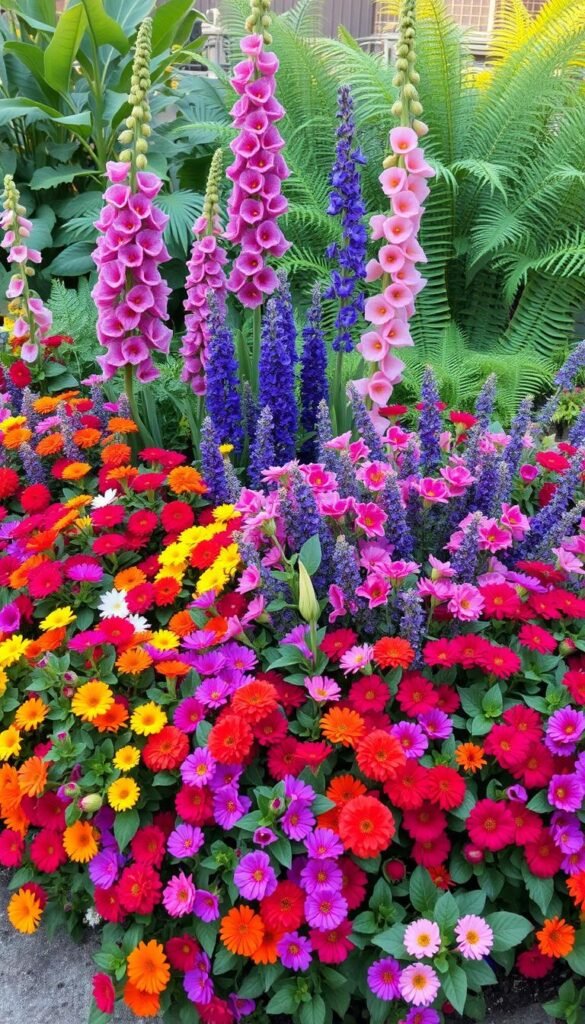
Even the tiniest planting areas can feel expansive with smart layering techniques. By arranging greenery in strategic tiers, you craft depth that draws the eye inward. This approach works wonders for narrow borders or raised beds, transforming flat spaces into dynamic displays.
Layering Plants for Depth and Visual Interest
Start with tall statement plants like foxgloves or ornamental grasses at the back. Mid-height blooms such as coneflowers fill the middle layer, while creeping thyme or sedum spill over front edges. “This structure creates a natural rhythm,” explains Portland landscaper Elena Cruz. “It guides the viewer’s gaze while maximizing every inch.”
Before choosing species, research your region’s native options. Local wildflowers often thrive with minimal care and support pollinators. Check sunlight patterns—place sun-loving marigolds where they’ll get six hours of light, but tuck hostas into shaded corners.
Color coordination elevates your design. Pair warm-toned daylilies with cool purple salvias for contrast, or blend varying shades of pink for monochromatic harmony. For more creative gardening ideas, experiment with foliage textures—silver sage leaves add shimmer beside velvety pansies.
Pro tip: Use evergreen groundcovers like ajuga to maintain structure during colder months. They’ll keep your bed looking intentional year-round while reducing replanting efforts.
Creative Plant Combinations for a Mini Oasis
Crafting eye-catching arrangements starts with understanding how plants interact. Evergreen anchors like English ivy offer year-round structure while letting seasonal stars shine. Pair them with pansies in spring or petunias in summer for dynamic rotations that refresh your space effortlessly.
Pairing Complementary Colors
Boost visual impact by combining warm and cool tones. Burgundy coleus pops against lime-green sweet potato vines, while purple pansies intensify yellow coreopsis. “Contrast creates depth,” notes gardener Elena Cruz. “A single red geranium can energize an entire planter of white alyssum.”
Try the thriller, filler, spiller formula for balanced designs. Use feathery grasses as vertical accents, bold coleus for mid-level drama, and creeping Jenny to soften edges. This layered approach works in pots under 12 inches wide—perfect for tight corners.
“Ivy’s versatility makes it my go-to base plant. Swap seasonal blooms around it, and you’ve got four distinct looks yearly without replanting everything.”
Rotate flowers based on sunlight changes. Shade-loving impatiens thrive where summer sun scorches spring primroses. Textural variety matters too—pair velvety lamb’s ear with spiky dianthus for tactile interest. Your mini garden becomes a living collage that evolves with nature’s rhythm.
Utilizing Vertical Space with Trellises and Wall Gardens
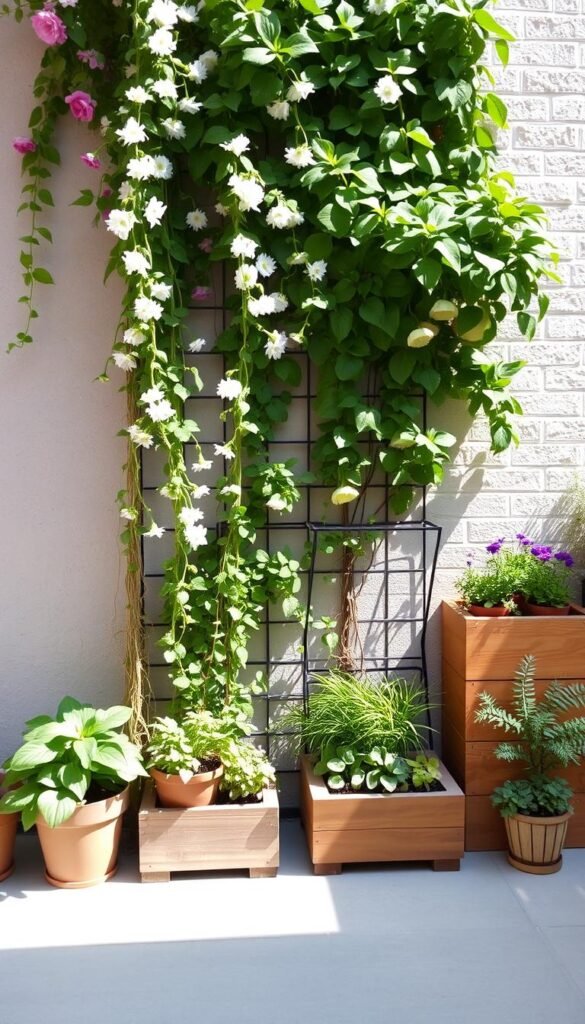
Unused walls and fences hold untapped potential for growing vibrant displays. Vertical gardening turns blank surfaces into lush focal points, letting you multiply your planting area without sacrificing floor space. A well-placed trellis or wall-mounted system adds depth while softening harsh lines in urban settings.
Selecting Vertical Planters That Pop
Choose materials that complement your outdoor aesthetic while supporting plant health. Powder-coated metal planters offer modern appeal, while wooden lattice trellises blend with natural surroundings. For small trees like dwarf citrus, opt for deeper containers with built-in irrigation.
Modular systems let you mix sizes—hang herb pockets beside cascading ferns. Ensure wall-mounted units have sturdy brackets, especially for wind-prone areas. “Lightweight fiberglass planters withstand weather while mimicking terra cotta’s charm,” suggests landscape designer Rosa Mendez.
Innovative Wall-Mounted Ideas
Transform fences into living tapestries with climbing roses or clematis. Install horizontal planters between posts for herbs or strawberries—they’ll thrive at eye level. Repurpose old ladders as tiered stands for succulents, creating movable green sculptures.
For renters, removable adhesive hooks hold lightweight plastic troughs. Fill them with trailing ivy or seasonal pansies. Want edible options? Try compact cherry tomatoes in pocket planters—they’ll drape beautifully as they grow.
Pro tip: Train fruit trees like columnar apples against sunny walls. Their narrow forms maximize yield in tight spaces while adding architectural interest. Pair with ornamental grasses below for textural contrast.
Budget-Friendly Tips for Small Garden Spaces
Growing a lush oasis doesn’t require deep pockets—just creativity and resourcefulness. By reimagining everyday items and prioritizing smart investments, you can cultivate vibrant displays while staying thrifty. Let’s explore how to stretch your gardening budget without sacrificing style.
Upcycling Everyday Items Into Planters
Your home holds hidden potential for unique pots. Old colanders become hanging baskets with built-in drainage, while chipped teacups transform into succulent displays. Try painting mismatched tin cans for cohesive herb gardens or drilling holes in wooden crates for rustic veggie planters.
Check thrift stores for baskets or galvanized buckets—line them with burlap to retain soil. Even cracked ceramic bowls work for shallow-rooted flowers. “A little imperfection adds character,” says Denver gardener Tara Ellis. “Just ensure containers drain properly to keep roots healthy.”
Starting with Seeds and Smart Shopping
Seeds outshine store-bought plants in value—a $3 packet grows 20+ blooms. Begin with easy varieties like marigolds or basil. Join local gardening groups for free cuttings or plant swaps—many communities host spring exchanges.
Time purchases wisely: buy soil in fall sales and pots during winter clearance. Compost kitchen scraps to create rich fertilizer, reducing waste and costs. For small-space efficiency, focus on compact varieties like dwarf sunflowers that thrive in tight quarters.
“I’ve grown entire patio gardens from seed packets and recycled containers. It’s rewarding to see what flourishes with minimal investment.”
Seasonal Planting Guide for Year-Round Blooms
Your petite green space can dazzle through every season with smart plant rotations. Succession planting ensures something always catches the eye, from spring’s first whispers to winter’s quiet defiance. Timing matters—learn when to swap spent blooms for fresh stars.
Spring and Summer Highlights
Grape hyacinths kick off the show, their cobalt-blue spikes emerging as frost retreats. Group them tightly in containers—their small flowers create bold impact when clustered. As days warm, replace them with heat-loving marigolds. These golden champions thrive through July’s peak, especially when underplanted with sweet alyssum’s snow-white carpet.
For summer drama, pair sunset-hued zinnias with spiky salvias. “This combo handles midday sun while attracting pollinators all day,” notes Colorado grower Jenna Park. Water deeply but less frequently to build drought resilience. Rotate pots weekly for even growth.
Fall and Winter Wonders
When autumn arrives, ornamental kale takes center stage. Its ruffled purple leaves pair perfectly with pearl millet’s feathery plumes. Add orange mums for Halloween flair—they’ll last until first frost. Pro tip: Tuck pansy seedlings between kale stems for instant color bursts.
Winter doesn’t mean barren pots. Heather’s evergreen sprigs and cyclamen’s heart-shaped leaves bring life to gray days. Cluster them near entryways where their subtle hues shine. Protect roots with mulch during freezes, then watch them rebound on milder days.
“Rotate three core containers each season. Store bulbs in breathable bags over winter—they’ll reward you year after year.”
Transition plantings two weeks before frost dates for seamless changes. Clean containers thoroughly between seasons to prevent disease. With this rhythm, your arrangements become a living calendar marking nature’s cycles.
Incorporating Edging and Retaining Walls in Mini Gardens
Sharp edges and smart structures turn cozy plots into intentional designs. Clean lines separate your vibrant flower beds from surrounding areas, adding instant polish. Whether using rustic bricks or sleek limestone, these elements create visual order while boosting functionality.
Choosing Materials That Define Your Space
Bricks offer timeless charm for curved or straight borders. Stack them vertically for a modern twist or lay horizontally for cottage appeal. Wooden logs bring natural warmth to raised beds, while flat stones create organic pathways. For sloped spaces, retaining walls made of concrete blocks or stacked limestone add usable tiers.
Match materials to your garden’s personality. Recycled railroad ties suit rugged themes, while painted metal strips shine in contemporary setups. “Edging isn’t just practical—it frames your plants like artwork,” says landscaper Diego Ruiz. Keep heights under 12 inches to maintain proportion in small areas.
Enhancing Garden Structure with Simple Techniques
Define bed boundaries by trenching a 3-inch groove along your layout. Backfill with gravel to deter grass invasion. For quick upgrades, press pavers flush with the soil—their crisp edges highlight blooms without overwhelming them.
Retaining walls need proper drainage. Add perforated pipes behind the first layer of stones or blocks. Fill gaps with gravel to prevent water buildup. Even a single-tier wall creates planting pockets for trailing thyme or dwarf marigolds.
“A well-edged bed makes maintenance easier. My clippers know exactly where to stop!”
These techniques require basic tools—a shovel, level, and rubber mallet. Build incrementally, testing stability as you go. Your structured space will feel larger while keeping plants neatly contained.
Creating Intimate Garden Nooks with Seating Areas
Your outdoor space becomes a sanctuary when you blend greenery with thoughtful seating. Start by carving out corners where foliage frames relaxation zones—think under a flowering tree or beside a climbing rose trellis. These spots invite you to pause and connect with nature daily.
Designing Cozy Outdoor Corners
Use natural dividers like tall grasses or potted shrubs to define your nook. Add texture with weather-resistant cushions in earthy tones that complement nearby blooms. A small bench tucked between lavender bushes creates a fragrant retreat, while foldable chairs adapt to impromptu gatherings.
For shade, drape outdoor curtains or position seating under a pergola. String lights above add evening charm. Explore seating ideas for gardens using repurposed materials—old wooden crates become side tables, and tree stumps serve as rustic stools.
Arranging Seating for Maximum Relaxation
Angle chairs toward garden highlights—a bubbling fountain or vibrant flower bed. Keep pathways clear by using narrow benches against walls. In tight spaces, try a corner-built bench with storage underneath for tools or cushions.
Layer comfort with washable throws during cooler months. For flexibility, choose lightweight chairs you can move to chase sunlight or shade. A well-placed seating area turns even modest gardens into destinations for unwinding and enjoying your botanical handiwork.

